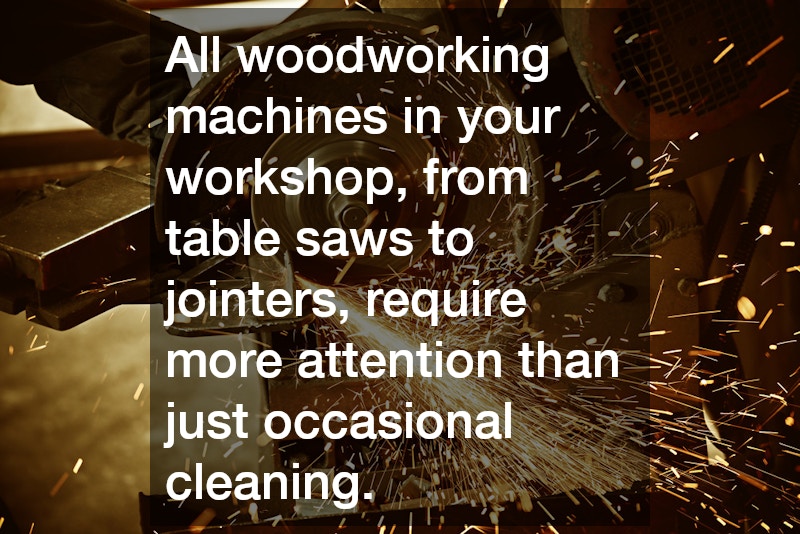

Your woodworking equipment is an extension of your creativity and craftsmanship. Whether you’re a seasoned artisan or a passionate hobbyist, it’s essential to properly maintain your tools to ensure they last as long as possible. Those molder knives must stay sharp to keep on producing perfect profiles in wood, and your professional woodshop tools that form the backbone of your projects must be looked after to make sure your clients love your work. With proper care, these tools will increase your efficiency and the quality of your work.
All woodworking machines in your workshop, from table saws to jointers, require more attention than just occasional cleaning. Each piece of woodwork equipment plays a crucial role in your projects, and neglecting them can lead to subpar performance, wasted materials, and even safety hazards. In this comprehensive guide, we will show you the best practices for maintaining the functionality of your tools. You will learn how regular maintenance can significantly extend the life of your equipment. We will cover everything from cleaning techniques to storage solutions and provide you with the knowledge to make every cut, joint, and finish reflect the mastery you strive for. Let’s get started enhancing and optimizing your woodworking experience!


If you do a lot of work with wood, you probably already know the importance of maintaining your tools. They are your lifeblood in a lot of ways. You probably spent a decent amount of money on your tools and want to keep them in the best shape possible. You want to keep your sharp tools sharp on your own, for example. That way you do not have to keep going to a tool sharpening service to get them back to the shape you need them to be in. While you probably know the importance of proper tool maintenance, you may not know how to perform that maintenance. Here are some tips to keeping your tools in tip top shape.
Set dates when you plan to do your tool maintenance. This can be a tool management schedule. You need to get into the habit of performing proper maintenance on your tools. If you wait until you find that your wood cutting tools are no longer working as well as they should, the damage has already been done and you have past the maintenance stage and moved squarely into the repair or replace stage. Both are more expensive than just properly maintaining the tools.
Another problem with waiting until you notice your tools are really not performing the way they should is this can become a problem not just with tool performance but with your safety. Woodworking cutting tools are not always like other kinds of tools. You have to pay close attention sometimes to see when they are not performing at the right level. That is why the schedule is so important. Then, they never get to the point where performance is an issue.
One option is to create a spreadsheet with all of your tools, the dates you maintained them and when you plan to maintain them in the future. If applicable, you can include data on when they were last taken care of by a tool sharpening service. Keep the manuals that came with your tools for reference.
Hand Tools
To keep the cutting edge of your woodworking hand tools in good shape, you should get yourself a set of files and a decent bench. Your files should come in fine, course and something that is somewhere in the middle. After you have used the files, you need to sharpen the blade with a sharpening stone. Another option is a grinding wheel that makes the process a whole lot easier.
Never use your cutting surfaces on non-wood items. Do not toss your wood cutting tools into your toolbox with everything else. It is tempting to do that, especially after a long day. When you give into that urge, those sharp edges become dull quickly by being knocked around in the toolbox where they bounce against everything else you have in there. The more you do this, the more often you will have to visit your local tool sharpening service. Just take care to put them away properly each and every time you use them and you will extend the life of the cutting edges.
Power Tools
Eventual replacement and/or tool sharpening is inevitable for most power tools. Different tools need different things. It probably makes more sense to just replace anything with cutting teeth as even using a tool sharpening service does not make sense. It is just cheaper to buy new ones. If you start with a really good quality blade, you can lengthen the time between replacements. Being careful about what surfaces you use them on is an important factor in how long they last as well.
Circular saw and table saw blades can and should be taken to a tool sharpening service that specializes in these kinds of tools. As with other blades, the better quality blades will stay sharp longer.
Fixed Woodworking Tools
These need maintenance, too. The blades also need to be sharpened and replaces as needed but the equipment also needs regular cleaning and proper lubrication. This will keep your equipment in tip top shape. The best thing you can do is read and keep all of the manuals that came with your equipment. Follow their instructions.

